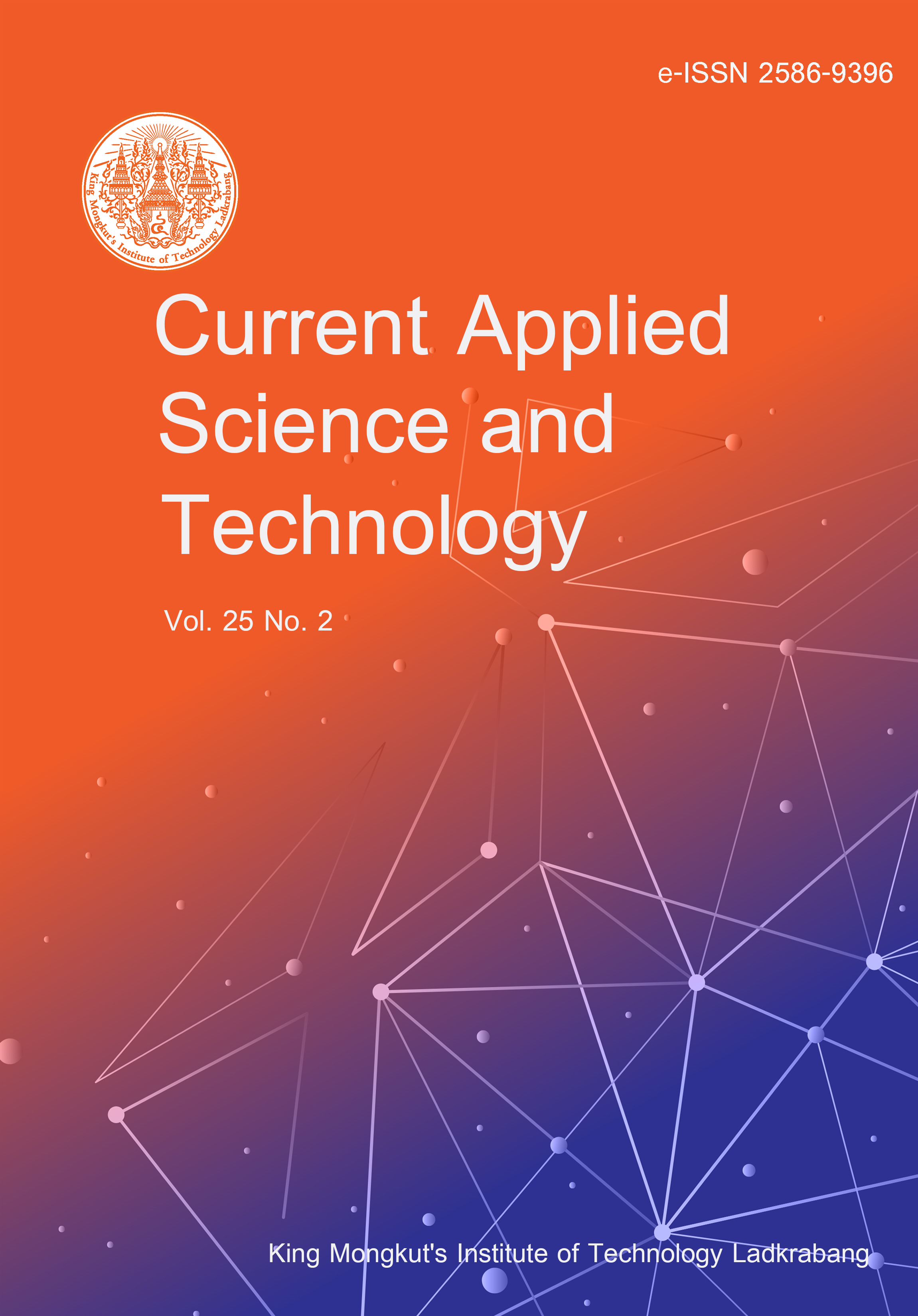The Effect of O2 Flow Rate on Nanostructured TiO2 Thin Films Prepared by Reactive DC Magnetron Sputtering with OAD Technique
Main Article Content
Abstract
In this project, we explored how different oxygen flow rates influenced the creation of TiO2 nanostructures in thin films using magnetron sputtering preparation with oblique angle deposition (OAD) technique. The experiment involved oxygen flow rates of 20, 40, 60, 80 and 100 sccm along with a constant argon flow at 20 sccm. Morphological analysis by FE-SEM was performed to determine film thickness and deposition rate. In a subsequent stage, thin films thickness was confirmed to be 100 nm. After coating, specimens were annealed at 300°C for 2 h using various O2 flow rates. FE-SEM revealed morphological changes, GIXRD to explore crystal structures, and UV-Vis spectrophotometry to measure light transmittance. The results showed an optimal oxygen flow rate at 60 sccm, with annealed specimens exhibiting anatase structure and promising light transmittance of 73-83%.
Article Details

This work is licensed under a Creative Commons Attribution-NonCommercial-NoDerivatives 4.0 International License.
Copyright Transfer Statement
The copyright of this article is transferred to Current Applied Science and Technology journal with effect if and when the article is accepted for publication. The copyright transfer covers the exclusive right to reproduce and distribute the article, including reprints, translations, photographic reproductions, electronic form (offline, online) or any other reproductions of similar nature.
The author warrants that this contribution is original and that he/she has full power to make this grant. The author signs for and accepts responsibility for releasing this material on behalf of any and all co-authors.
Here is the link for download: Copyright transfer form.pdf
References
Binas, V., Venieri, D., Kotzias, D., & Kiriakidis, G. (2017). Modified TiO2 based photocatalysts for improved air and health quality. Journal of Materiomics, 3(1), 3-16. https://doi.org/10.1016/j.jmat.2016.11.002
Castrejón-Sánchez, V. H., López, R., Ramón-González, M., Enríquez-Pérez, Á., Camacho-López, M., & Villa-Sánchez, G. (2019). Annealing control on the anatase/rutile ratio of nanostructured titanium dioxide obtained by sol-gel. Crystals, 9(1), Article 22. https://doi.org/10.3390/cryst9010022
Hanaor, D. A. H., & Sorrell, C. C. (2011) Review of the anatase to rutile phase transformation. Journal of Materials Science, 46(4), 855-874. https://doi.org/10.1007/s10853-010-5113-0
Jalali, E., Maghsoudi, S. & Noroozian, E. (2020). A novel method for biosynthesis of different polymorphs of TiO2 nanoparticles as a protector for Bacillus thuringiensis from ultra violet. Scientific Reports, 10. Article 426. https://doi.org/10.1038/s41598-019-57407-6
Khan, J., & Han, L. (2023). Oxygen vacancy in TiO2: Production methods and properties. In B. Bejaoui (Ed.). Updates on titanium dioxide. IntechOpen. https://doi.org/10.5772/intechopen.111545
Kwon, H., Lee, S. H. & Kim, J. K., (2015). Three-dimensional metal-oxide nanohelix arrays fabricated by oblique angle deposition: Fabrication, properties, and applications. Nanoscale Research Letters, 10, Article 369. https://doi.org/10.1186/s11671-015-1057-2
Mekkaoui, A., Temam, E.G., Rahmane, S. & Gasmi, B. (2023). A new study on the effect of pure anatase TiO2 film thickness on gentian violet photodegradation under sunlight: Considering the effect of hole scavengers. Trends in Sciences, 20(1), Article 3766. https://doi.org/10.48048/tis.2023.3766
Ogwu, A. A., Bouquerel, E., Ademosu, O., Moh, S., Crossan, E., & Placido, F. (2005). The influence of rf power and oxygen flow rate during deposition on the optical transmittance of copper oxide thin films prepared by reactive magnetron sputtering. Journal of Physics D: Applied Physics, 38(2), Article 266. https://doi.org/10.1088/0022-3727/38/2/011
Tachibana, Y., Ohsaki, H., Hayashi, A., Mitsui, A. & Hayashi, Y. (2000). TiO2−X sputter for high rate deposition of TiO2. Vacuum, 59(2-3), 836-843. https://doi.org/10.1016/S0042-207X(00)00354-7
Vargas, M. A., & Rodríguez-Páez, J. E. (2017). Amorphous TiO2 nanoparticles: Synthesis and antibacterial capacity, Journal of Non-Crystalline Solids, 459, 192-205. https://doi.org/10.1016/j.jnoncrysol.2017.01.018
Venkatachalam, S., Hayashi, H., Ebina, T., & Nanjo, H. (2013). Preparation and characterization of nanostructured TiO2 thin films by hydrothermal and anodization methods. In S. Pyshkin & J. Ballato (Eds.). Optoelectronics-Advanced materials and devices (pp. 115-136). IntechOpen. https://doi.org/10.5772/51254
Wei, Y., Meng, H., Wu, Q., Bai, X., & Zhang, Y. (2023). TiO2-based photocatalytic building material for air purification in sustainable and low-carbon cities: A review. Catalysts, 13(12), Article 1466. https://doi.org/10.3390/catal13121466






